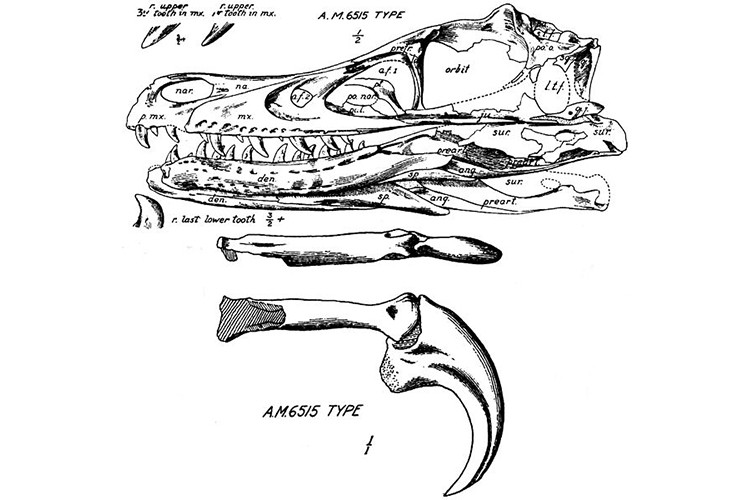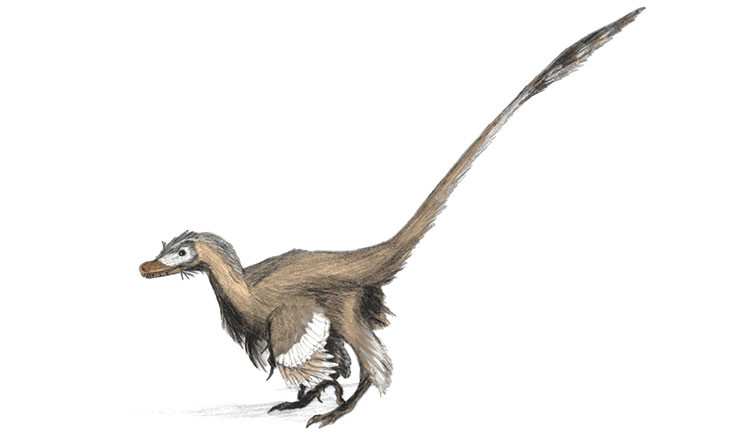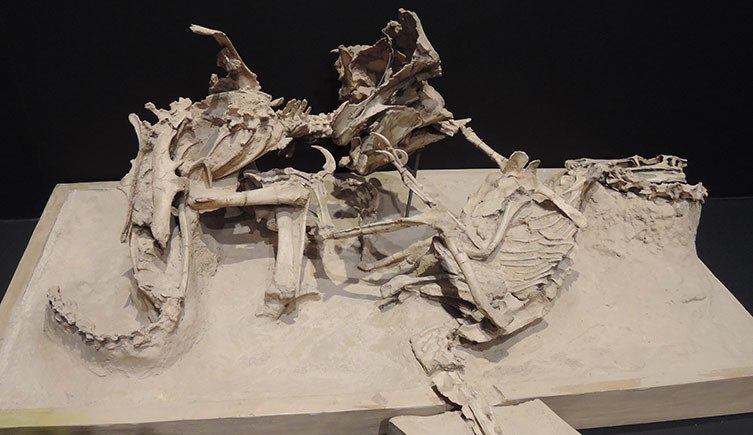Could Velociraptors Fly? No, velociraptors could not fly, despite having feathers and wing-like arms; however, this does not make them any less fascinating. At flyermedia.net, we delve into the science behind these incredible creatures, separating fact from fiction in the world of paleontology and aviation. Let’s soar through the prehistoric skies and uncover the grounded reality of velociraptors and their aviation aspirations!
1. What Exactly Was a Velociraptor?
Velociraptors were turkey-sized theropod dinosaurs from the Cretaceous Period, known for their intelligence, speed, and distinctive sickle-shaped claw on each foot. According to research from the American Museum of Natural History, Henry Fairfield Osborn published a description of the finds in 1924, but he assumed the large, curved claw was from the hand. These predators roamed the earth approximately 75 to 71 million years ago, leaving behind a legacy that continues to captivate scientists and enthusiasts alike.
1.1 Unearthing the Past: Discovery and Classification
The first Velociraptor fossil, an impressive claw and crushed skull, was discovered in 1923 in Mongolia’s Gobi Desert, marking the beginning of our understanding of these swift predators. According to paleontologist Dr. David Button, the claw looks just like the talon of an eagle, which is used to grip prey and pin it down. Velociraptor probably used its sickle-shaped talon in the same way to injure, subdue and grip its prey, before dispatching it with its jaws. Velociraptors belong to the dromaeosaurid family, a group of bird-like dinosaurs characterized by their agility and predatory behaviors.
1.2 Anatomy of a Hunter: Size, Claws, and Teeth
Velociraptors were relatively small dinosaurs, measuring about 6.8 feet long and weighing around 33 pounds, yet their anatomy was perfectly designed for hunting. Their most distinctive feature was the large, sickle-shaped claw on each foot, which they likely used to slash and restrain prey.
 Drawing of the first Velociraptor skull and claw ever found
Drawing of the first Velociraptor skull and claw ever found
Their jaws were equipped with sharp, serrated teeth that curved backward, ensuring a secure grip on their victims.
1.3 Habitat and Lifestyle: Where Did They Roam?
Velociraptors inhabited the arid environments of present-day Mongolia and China during the Late Cretaceous period. These dinosaurs were likely active hunters, preying on small mammals, reptiles, and even juvenile dinosaurs. As agile and intelligent predators, Velociraptors played a crucial role in their ecosystems, helping to regulate prey populations and maintain ecological balance.
2. Unpacking the Winged Mystery: Did Velociraptors Really Have Feathers?
Velociraptors did indeed have feathers, a revelation that has reshaped our understanding of these dinosaurs and their relationship to modern birds. According to paleontologist Dr. David Button, they’d actually be much creepier because it would be something we recognise but a bit wrong. Fossil evidence, including the discovery of quill knobs on Velociraptor bones, indicates that these dinosaurs possessed long feathers on their arms, similar to those of modern birds.
2.1 Feathered Friends: Evidence of Feathers in Velociraptors
The discovery of feathered Velociraptor fossils has provided compelling evidence of the presence of feathers in these dinosaurs. Quill knobs, small bumps on the ulna bone where feathers attach, have been found on Velociraptor fossils, confirming that these dinosaurs had feathers on their forearms. These feathers were likely used for display, insulation, and possibly even gliding.
2.2 Function of Feathers: Display, Insulation, or Flight?
While Velociraptors had feathers, they were not capable of true flight. Instead, their feathers likely served other purposes, such as attracting mates through elaborate displays.
 Palaeoart reconstruction of Velociraptor
Palaeoart reconstruction of Velociraptor
These feathers could have also provided insulation, helping Velociraptors regulate their body temperature in the harsh desert environments they inhabited. While flight may not have been possible, some scientists believe that Velociraptors may have used their feathered arms to glide short distances or enhance their agility while running.
2.3 Evolutionary Implications: Linking Dinosaurs and Birds
The presence of feathers in Velociraptors and other theropod dinosaurs supports the theory that birds evolved from dinosaurs. This evolutionary link is further strengthened by similarities in skeletal structure, reproductive biology, and behavior between dinosaurs and birds. The feathered Velociraptor serves as a powerful reminder of the close relationship between these two groups, blurring the lines between dinosaurs and birds.
3. The Big Question: Could Velociraptors Actually Take to the Skies?
No, Velociraptors could not fly, despite their feathered appearance and wing-like arms. According to paleontologist Dr. David Button, it didn’t have the apparatus needed to get an animal of its size off the ground. Although it had a wishbone (fused collarbone) like in modern birds, it wasn’t the shape needed to support flapping wings. While they possessed feathers, their anatomy lacked the necessary adaptations for powered flight, such as strong flight muscles and lightweight bones.
3.1 Anatomical Limitations: Bone Structure and Muscle Power
Velociraptors’ bone structure and muscle power were not suited for flight. Unlike birds, which have hollow bones and powerful flight muscles, Velociraptors had dense bones and relatively weak forelimb muscles. These anatomical limitations would have made it impossible for Velociraptors to generate the lift and thrust required for sustained flight.
3.2 Wing Size and Shape: Unsuitable for Flight
The size and shape of Velociraptors’ wings were also unsuitable for flight. Their wings were relatively small compared to their body size, and they lacked the aerodynamic features necessary for generating lift. The feathers on their wings were also symmetrical, unlike the asymmetrical feathers of flying birds, which are essential for generating thrust and controlling flight.
3.3 Aerodynamic Inefficiency: Why Gliding Wasn’t an Option
Even gliding would have been challenging for Velociraptors due to their aerodynamic inefficiency. Their body shape and wing structure were not optimized for gliding, making it difficult for them to generate lift and maintain stability in the air. While they may have been able to glide short distances, sustained gliding or soaring flight would have been beyond their capabilities.
4. Unraveling the Mystery: Why Did Velociraptors Have Feathers If They Couldn’t Fly?
Velociraptors’ feathers likely served a variety of functions, including display, insulation, and brooding, rather than flight. According to paleontologist Dr. David Button, feathers would stop dromaeosaurs losing energy and keep them warm. These functions would have been crucial for their survival in the harsh environments they inhabited.
4.1 Display Purposes: Attracting Mates and Signaling
One of the primary functions of Velociraptors’ feathers may have been display. Brightly colored or patterned feathers could have been used to attract mates and signal social status within their groups. Display feathers could have also played a role in territorial defense, allowing Velociraptors to intimidate rivals and protect their resources.
4.2 Insulation: Keeping Warm in a Cold Climate
Feathers could have also provided insulation, helping Velociraptors regulate their body temperature in the cold, arid environments they inhabited. A layer of feathers would have trapped air close to their bodies, providing insulation and reducing heat loss. This insulation would have been particularly important for Velociraptors during the colder months, allowing them to conserve energy and survive in harsh conditions.
4.3 Brooding: Protecting Eggs and Young
Another possible function of Velociraptors’ feathers is brooding, the act of sitting on eggs to keep them warm and protected. Feathered arms could have been used to cover nests while brooding, providing insulation and shielding the eggs from the elements. This brooding behavior would have increased the chances of successful hatching and offspring survival, contributing to the reproductive success of Velociraptors.
5. Beyond the Myths: Understanding Velociraptor Behavior and Ecology
Velociraptors were complex and fascinating creatures with behaviors and ecological roles that extended far beyond the myths perpetuated by popular culture. According to paleontologist Dr. David Button, Velociraptor probably mostly fed on relatively small mammals and reptiles that would have been easy to overpower and kill. That said, it may have occasionally hunted small, infant dinosaurs.
5.1 Hunting Strategies: Pack Hunters or Solitary Predators?
The hunting strategies of Velociraptors are still debated among scientists, with some arguing that they were pack hunters and others suggesting that they were solitary predators. The idea of Velociraptor pack hunting is based on fossil evidence of multiple Deinonychus individuals found near a Tenontosaurus carcass. However, this evidence is not conclusive, and it is possible that these individuals were scavenging or that the association was coincidental.
5.2 Diet and Prey: What Did They Eat?
Velociraptors were primarily carnivorous, feeding on a variety of small animals, including mammals, reptiles, and juvenile dinosaurs. Their sharp teeth and powerful claws were well-suited for capturing and dismembering prey. Fossil evidence suggests that Velociraptors may have also scavenged on occasion, supplementing their diet with carrion when available.
 Fighting dinosaurs fossil
Fighting dinosaurs fossil
5.3 Social Structure: Living in Groups or Solitary Lives?
The social structure of Velociraptors is not well understood, but some evidence suggests that they may have lived in groups or family units. Fossil trackways of multiple individuals moving in the same direction indicate that Velociraptors may have engaged in social behaviors. Living in groups could have provided Velociraptors with benefits such as increased hunting efficiency and protection from predators.
6. The Legacy of Velociraptor: Pop Culture, Scientific Advancements, and Aviation Inspiration
Velociraptors have left an indelible mark on pop culture, scientific understanding, and even the world of aviation. According to paleontologist Dr. David Button, there’s a weird urban myth that Velociraptor has a higher encephalisation quotient than humans. It clearly doesn’t. The Velociraptor’s legacy serves as a reminder of the power of scientific discovery and the endless fascination that dinosaurs hold for people of all ages.
6.1 Velociraptor in Pop Culture: From Jurassic Park to Beyond
Velociraptors have become iconic figures in popular culture, thanks to their portrayal in movies like Jurassic Park. While the Velociraptors depicted in these films are often larger and more intelligent than their real-life counterparts, they have captured the imaginations of audiences worldwide. The Velociraptor’s image has been used in countless books, video games, and other media, solidifying its place as one of the most recognizable dinosaurs in the world.
6.2 Scientific Advancements: How Velociraptor Shaped Paleontology
The study of Velociraptors has played a crucial role in advancing our understanding of dinosaur evolution, behavior, and ecology. Discoveries related to Velociraptors, such as the presence of feathers and the discovery of the “Fighting Dinosaurs” fossil, have provided valuable insights into the lives of these fascinating creatures. The ongoing research on Velociraptors continues to shape the field of paleontology, inspiring new discoveries and challenging old assumptions.
6.3 Inspiration for Aviation: Learning From Nature’s Designs
While Velociraptors couldn’t fly, their anatomy and adaptations have served as a source of inspiration for aviation engineers and designers. The study of Velociraptors’ feathers, bone structure, and muscle attachments has provided valuable insights into the principles of flight and aerodynamics. By learning from nature’s designs, engineers can create more efficient and effective aircraft, pushing the boundaries of aviation technology.
7. FAQ: Frequently Asked Questions About Velociraptors and Flight
7.1 Did Velociraptors have wings?
Velociraptors had feathered arms that resembled wings but were not capable of flight.
7.2 What did Velociraptors use their feathers for?
Velociraptors used their feathers for display, insulation, and possibly brooding.
7.3 Were Velociraptors pack hunters?
The hunting strategies of Velociraptors are still debated, but evidence suggests they may have been solitary predators or opportunistic scavengers.
7.4 How fast could Velociraptors run?
Velociraptors could run at speeds of up to 40 kilometers per hour (25 miles per hour).
7.5 What did Velociraptors eat?
Velociraptors primarily ate small mammals, reptiles, and juvenile dinosaurs.
7.6 How big were Velociraptors?
Velociraptors were relatively small dinosaurs, measuring about 6.8 feet long and weighing around 33 pounds.
7.7 Where did Velociraptors live?
Velociraptors inhabited the arid environments of present-day Mongolia and China during the Late Cretaceous period.
7.8 Are birds related to Velociraptors?
Yes, birds are closely related to Velociraptors and other theropod dinosaurs.
7.9 How smart were Velociraptors?
Velociraptors were relatively intelligent dinosaurs, with a brain size comparable to that of modern birds.
7.10 What is the significance of the “Fighting Dinosaurs” fossil?
The “Fighting Dinosaurs” fossil provides a rare glimpse into the behavior of Velociraptors and their prey, capturing a moment of intense struggle between a Velociraptor and a Protoceratops.
8. Conclusion: Embracing the Fascination with Velociraptors and the Skies
While Velociraptors may not have soared through the skies, their existence continues to inspire awe and wonder. As we continue to explore the mysteries of these magnificent creatures, let us embrace the fascination with the past and the possibilities of the future.
Ready to explore more about the world of aviation? Visit flyermedia.net today to discover a wealth of information on flight training, aviation news, and career opportunities. Whether you dream of becoming a pilot, are fascinated by aircraft technology, or simply love the thrill of flight, flyermedia.net is your ultimate destination.
Address: 600 S Clyde Morris Blvd, Daytona Beach, FL 32114, United States
Phone: +1 (386) 226-6000
Website: flyermedia.net
